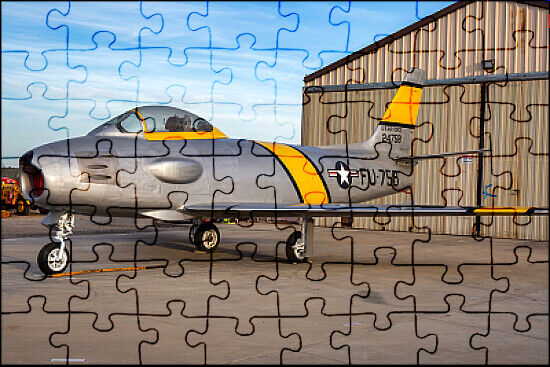Specifications
| Manufacturer: | North American | |
|---|---|---|
| Year/Model: | 1952 F-86F Sabre | |
| BU-S/N: | 524758 | |
| Tail Number: | FU-758 | |
| Power Plant: | 5,970 lb thrust, J47-GE-27 | |
| Wingspan: | 37 feet one inch | |
| Length: | 37 feet six inches | |
| Height: | 14 feet 8 inches | |
| Gross Weight: | 17,000 pounds | |
| Maximum Speed: | 690 mph | |
| Maximum Range: | 1,270 statute miles | |
| Service Ceiling: | 48,300 feet | |
| Crew: | 1 | |
| Status: | Static Display | |
| Owner: | On loan from National Naval Aviation Museum, Pensacola, FL | |
In Flight
History
This rare Sabre rolled in on a flat-bed truck 16 November 1997, transferred from NAWS China Lake. It was not a pretty sight. It took nearly a week to get the nose gear on, and the following week the wings and main gear went on, then the tail section was added at the end of March. Since then was a slow process of repairing damaged areas and locating original parts, and by March 1999 it was fully restored and in its rightful place on the Estrella Warbirds Museum ramp.
Originally a RF-86F, this is one of 18 modified by Mitsubishi in Japan for a then top-secret "Haymaker" reconnaissance program which envisioned penetration of "denied airspace" by the USAF in late-1950s Korea — the bulges beneath the canopy contained the electronic photo-surveillance packages using K-17 and K-22 cameras in an under-fuselage installation. Combat armament consisted of six .50 machine guns in the nose, which were removed when the camera packages were installed. There is only one RF-86F in flying condition worldwide, reportedly still in service to some lesser extent with the Republic of Korea Air Force.
The F-86F was basically a more powerful version of the F-86E, powered by a General Electric J47 turbojet of 5,910 pounds thrust. A contract was approved for 109 F models on April 11, 1951 and was increased to 360 aircraft by June. North American planned to build the F model in a leased facility in Columbus, Ohio, in order to accommodate the increased workload brought on by the Korean War.
By the time the Ohio production line opened, the order was up to 441 aircraft, so the North American factory in California began to produce F models as well. Over its production run, several block improvements were made to the F model, including flat armored windscreens, increased drop tank capacity, a new gun sight, revised flight control systems, increased wing area, provision for nuclear ordnance, and improved fighter-bomber capabilities.
These new capabilities -- especially the new, larger wing -- quickly boosted combat performance in Korea. The F-86F could now match the maximum speed of the MiG-15 all the way up to 47,000 feet, could turn inside the MiG, and could almost match the MiG's rate of climb. Between 8 May and May 31, 1953, F-86Fs with improved wings accounted for 56 MiG kills with only one loss.
On June 20, 1953 F-86F Sabres accounted for 16 aerial victories, the biggest one-day score of the war. The improved fighter-bomber version of the F-86F also proved highly suitable for air-to-ground work in Korea, and could easily take care of itself on the way home if jumped by enemy aircraft.
Following the Korean War, surplus F-86Fs were transferred to various American allies around the world through the Mutual Defense Assistance Program (MDAP). Foreign recipients included Taiwan, Japan, Pakistan, South Africa, Belgium, Norway, Spain, South Korea, the Philippines, Peru, Venezuela, Bolivia, Portugal, Tunisia, Ethiopia, Argentina, and Saudi Arabia.
Footnote: It was originally assumed that the aircraft was built by Mitsubishi under license from North American because it was a photo reconnaissance version of the fighter that was sold back by the Japanese to the US Navy to be used as a drone. It was confirmed the aircraft serial number from the Navy's paperwork with the data plate on the forward part of the fuselage. F-86F, S/N 52-4758 was built by North American in southern California for the USAF. Appearantly after arriving in Japan it was sold to the Japanese as part the Military Assistance Program. Mitsubishi later did build F-86F's under license, when North American was building later versions for the USAF. While flying for Japan, it was given the serial number 52-7401. At some time Mitsubishi converted the aircraft to an RF-86F. The aircraft is painted as it would have appreared flying for the USAF in Korean in 1952 or 1953. Because all of the RF-86's had some or all of the machine guns removed, they were painted as 336th Fighter Interceptor Squadron aircraft to fool the other guys. Some aircraft actually had gun ports painted on the nose.
Just For Fun
How fast can you rebuild this aircraft?















